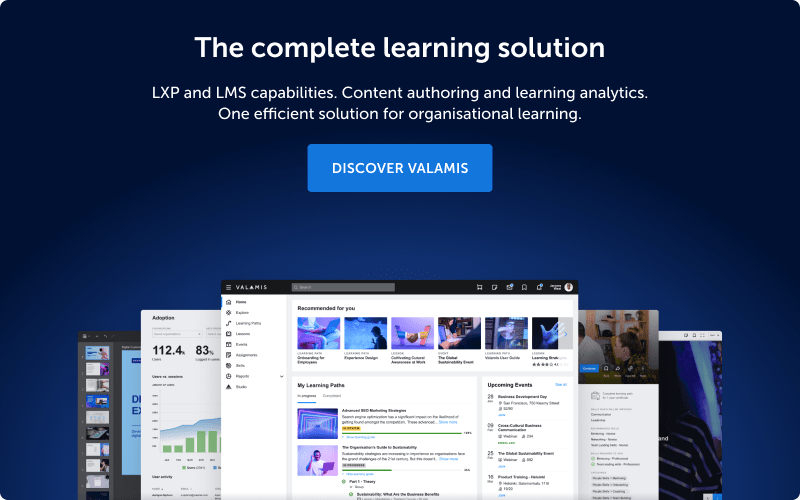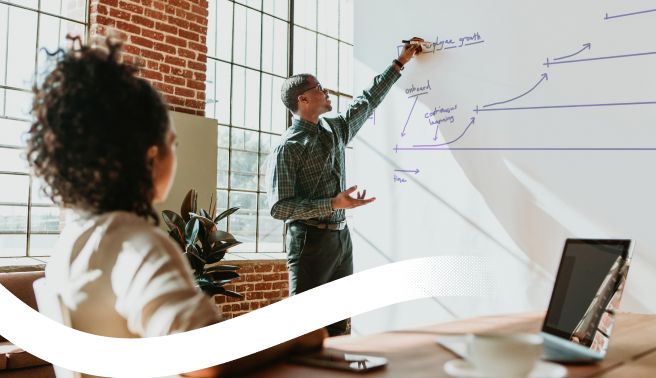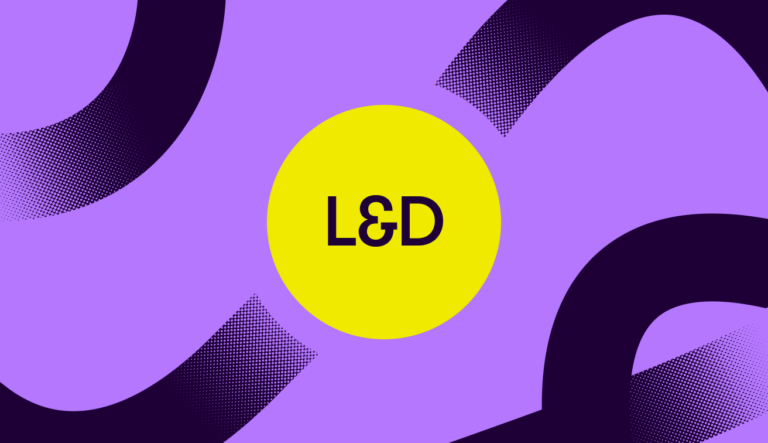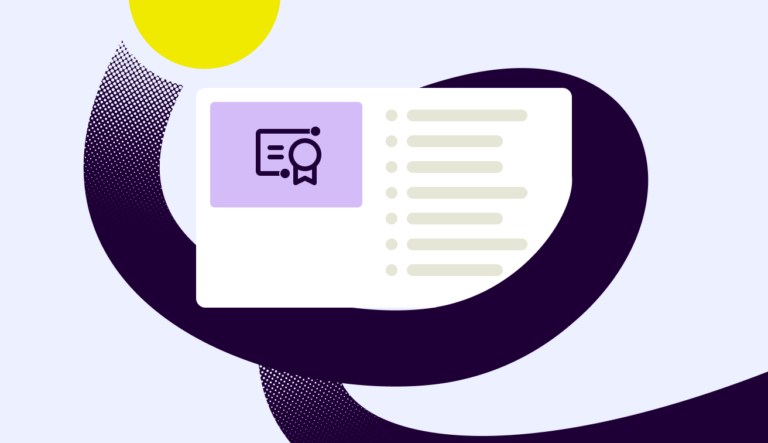What is a Learning Experience Platform?
Everything you need to know about the Learning Experience Platform: what is it, why LXPs emerged, key features & capabilities, LXP vs. LMS comparison.
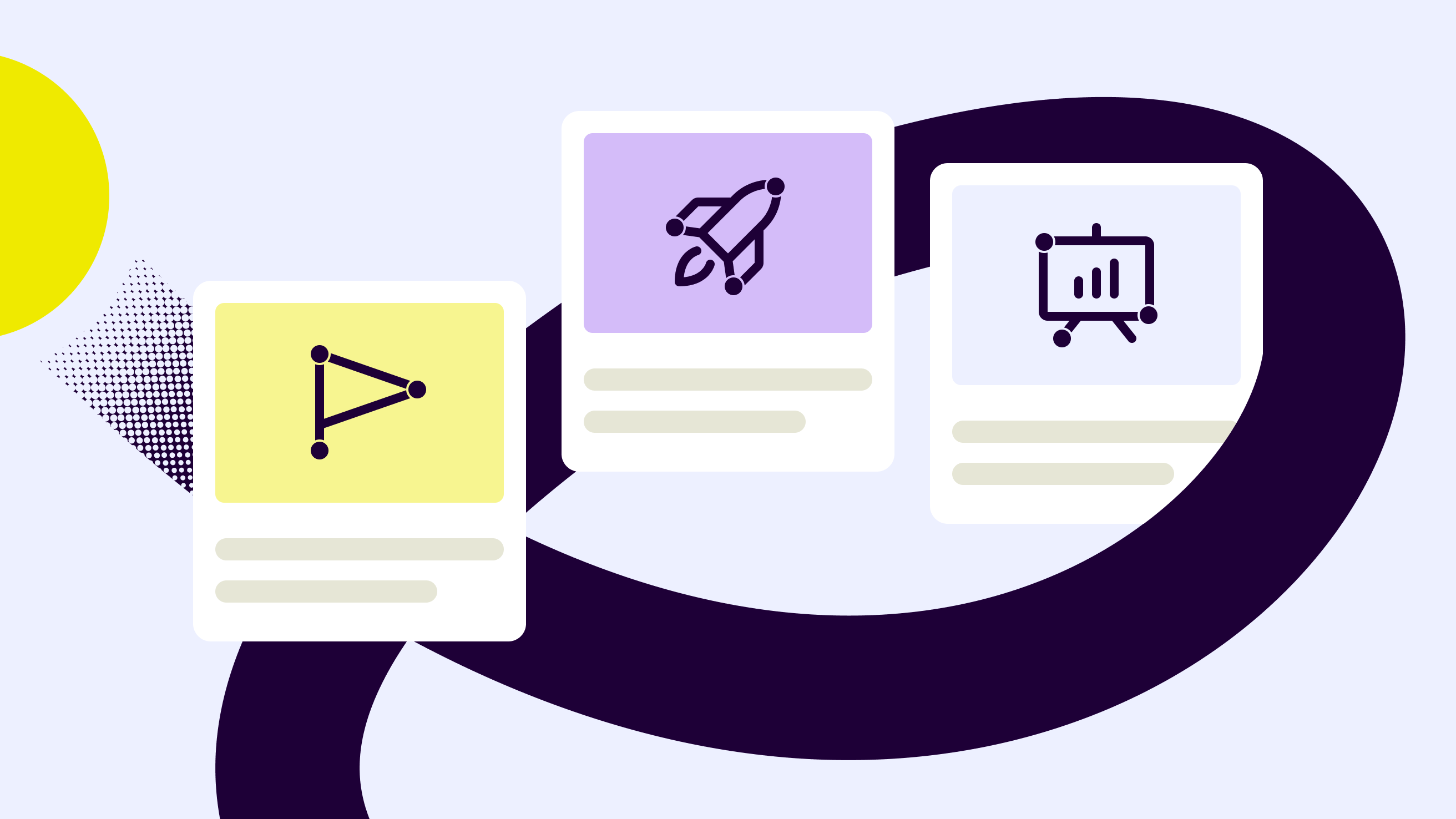
Organizations have been using old Learning Management Systems (LMSs) for a long time now. But as training requirements started changing, company executives, learning professionals and learners realized that there was something missing. There was a strong realization of the need for a more diverse and robust learning environment.
Discover:
- What is a Learning Experience Platform?
- The emergence of Learning Experience Platforms
- LXP enablers
- Key features of Learning Experience Platforms
- How do LXPs differ from LMSs?
- LXPs – Unlocking learner potential
Over the past half-decade or more, the corporate training landscape has seen a lot of innovation. More advanced approaches, such as lifelong learning, adaptive learning and engagement learning, are rapidly emerging to become mainstream.
Today, trainers deliver eLearning through a variety of specially designed tools and technologies that provide highly personalized learning.
The capabilities of those environments, combined with the unique types of experiences delivered to the learner, are what create Learning Experience Platforms (LXPs). And today, LXPs are a growing part of the learning ecosystem.
According to Josh Bersin, founder of Bersin by Deloitte: “…the LXP market itself is now over $350M in size and more than doubling every year. It’s also changing quickly”.
What is a Learning Experience Platform?
LXPs leverage innovative digital technologies to harness a wealth of internal digital learning assets, external 3rd-party content as well as user-generated resources to deliver highly customizable learning.
By making data the focus of an enterprise’s Learning & Development (L&D), LXPs enable companies to more effectively manage digital disruptions occurring across the workforce.
At a macro level, LXPs are a major shift from the traditional way of delivering corporate L&D. They provide opportunities to enhance engagement with platform users by helping them (learners) interact with the platform in a more personal way.
LXPs may include all the enabling consumer-grade tools and technologies that are used to design, develop, create, monitor and administer highly personalized learning environments. But they go much beyond that!

Checklist on how to choose the best LMS
The checklist will keep your focus on what really matters when choosing an LMS.
DownloadThe “openness” of LXP architecture means their capabilities can be leveraged by a much broader audience than before. And thanks to the wider variety of technology these platforms can support, L&D specialists have greater flexibility when integrating corporate and 3rd-party systems and tools into learning ecosystems. And because these platforms more ably support data-driven learning, senior decision-takers can better leverage them for more informed ROI-based learning policy-making purposes.
LXPs ability to connect to and integrate with other (existing) systems and tools implemented at companies and institutions, distinguishes these platforms, from learning ecosystems of the past.
By tapping into the data and capabilities of existing environments, and supplementing them with newer capabilities like Artificial Intelligence (AI) and Data Analytics, LXPs can proactively detect learning needs and deficiencies and define learning strategies to bridge those gaps.
LXPs take conventional training models a step further, by not just acting as curator, repository and dispenser of learning content and learning records, but serving as the backbone of corporate learning technology. The result: The delivery of a comprehensive, holistic and deeply personalized learning experience to anyone that uses the platform.
The emergence of Learning Experience Platforms
The bulwark of learning in most corporate entities is their Learning Management Systems (LMS). While LMS’s serve their primary purpose – which is to deliver training content to employees across the company – enterprise training needs have evolved to outpace what traditional LMS’s can deliver.
Probably the most important factor behind the emergence of newer experience-based platforms, including in the learning ecosystem, was the realization that businesses need to improve their products and services to give their customers a better experience. This was largely based on customer/learner reaction to existing platforms, including LMS’s.
1. A move towards personalization
Firstly, “old” LMS’s primarily served as a centralized catalog of corporate digital learning assets.
Users of those platforms often found it hard to navigate through vast amounts of content to find an appropriate piece of learning. LMS providers sought to bridge that gap by introducing smart searches and innovative querying features – but that didn’t entirely address the core challenge:
LMS’s were still like huge libraries where you should only go to when you have an idea of what you need, and then spend inordinate amounts of time searching for what you specifically want!
Today, with cutting-edge technologies offered by Google, Amazon, Facebook and Apple, and the vast variety of content – video, audio, graphical, text-based – available through their respective supported platforms, it’s much easier to turn there for learning resources than the corporate LMS.
Learners today are looking to personalized learning geared towards their needs and wants. And these new-age platforms make personalized learning quick and highly effective. Learners, who are accustomed to interacting with such platforms in their “after work” lives, came to expect the same with their corporate learning environments – and that’s what LMS lacked!
2. Pushing the boundaries of standards
Another driver for the emergence of LXP’s is the standards adopted by modern-day LMS’s – which are SCORM-based. While SCORM does “get results”, it is limited in what it can do. One of the main goals of any corporate learning platform is to connect learning with on-the-job performance. And SCORM makes it very difficult to decide how effective the courses really are, or how learners benefit from these courses.
Experience API (xAPI) on the other hand – the standard embraced by LXPs – offers significantly enhanced capabilities to the platform. When you use xAPI, you can follow different parameters both while you learn and perform on the job tasks. And, what’s even better is that you can do that on a variety of digital devices.
This allows you to track how learning influenced employee’s performance. For instance, with these new standards, you can now:
- Capture data from a vast array of sources
- Track learners activity via simulations and VR sessions
- Track where and how your employees learn (what devices they use)
- Assess to see how learners absorb the information in the course
- And most importantly, you can do all of this (and more!) using any device – so long as it can connect to the LXP either directly or remotely
All these advantages help you understand whether your training is truly effective and how it influences the work that people perform, which makes it easier to calculate ROI.
xAPI helps you understand what works and whether it makes sense to invest in something you wanted to invest originally and what should you really invest in.
3. Moving beyond “intelligence”
Many LMS solutions pride themselves as being “highly intelligent”. However, newer data processing and analytics technologies have pushed the need for enterprise learning solutions to go much beyond “intelligence”. And that’s exactly what LXP’s do!
Now, with the development of AI technologies everything has become even more interesting:
- Imagine you collect all this data about users, their behavior, performance, and learning, and provide it to an AI data engine. AI takes all that data and turns it into actionable information, telling you exactly what courses your learner needs to take.
- If you give it 1000 profiles, it will “learn” to predict what each learner needs based on patterns. This allows for preventing possible performance issues by recognizing them before they even occur.
But it doesn’t stop there!
Integrations are also possible with AI. If you integrate LXP and your Human Resource Management (HRM) system, the corporate intranet, your Learning Record Store (LRS) or the enterprise Customer Relationship Management (CRM) system, and collect the data from all of them, you can identify many different trends and patterns. And based on those patterns, all stakeholders can make informed training and learning decisions.
Standard LMS’s cannot do any of that. And though LMS developers are trying to get there, they’ve still got a long way to go to bridge the functionality gap with LXPs. As a result, there was an even greater impetus to the emergence of LXPs.
LXP enablers
Corporate digital transformation initiatives, which were in vogue across organizations, gave rise to new business models. This lead to the adoption of new platforms, known as Digital Experience Platforms (DXPs). Global technology research firm CMSWire defined DXPs as:
“…an integrated set of technologies, based on a common platform, that provides a broad range of audiences with consistent, secure and personalized access to information and applications across many digital touchpoints…”.
Because of their versatility and broad reach – both internally and externally – DXPs delivered more personalized experiences to company management, employees, customers and business partners. As all segments of the business adopted them, DXPs also proved to be a catalyst for the digital transformation of learning.
However, the lack of personalization, restricted standards and limited intelligence lead all stakeholders in the learning ecosystem – learners, trainers, employers, instructional designers and content developers – to realize the urgent need to bridge the gaps in existing learning platforms.
A significant set of drivers, that were catalysts for the digital transformation of the enterprise, also acted as enablers for a new paradigm in corporate learning – LXPs. Those drivers included:
1. The explosive growth of internet and mobile technologies
According to data consumption statistics compiled by Hootsuite and We Are Social in their Digital 2021 October Global Statshot Report, the number of mobile users had swelled to 5.29 billion users globally (+ 1.9% during 2021).
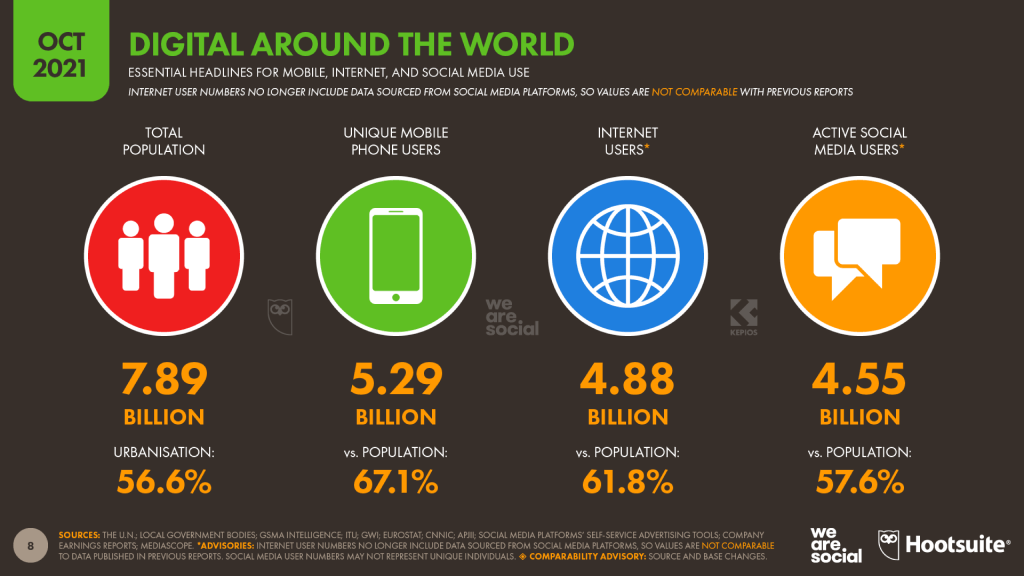
Take a look at how the number of internet users changed significantly for the past 10 years.

Over the past five years or so, there has been a dramatic increase in internet usage, and with that came a significant rise in mobile users.
The Covid-19 pandemic almost doubled the amount of mobile data that is used. In 2020 consumption was at 7.2GB (slightly less at 7.0 GB in 2019), and has increased by 61% to the current rate of 11.6GB.
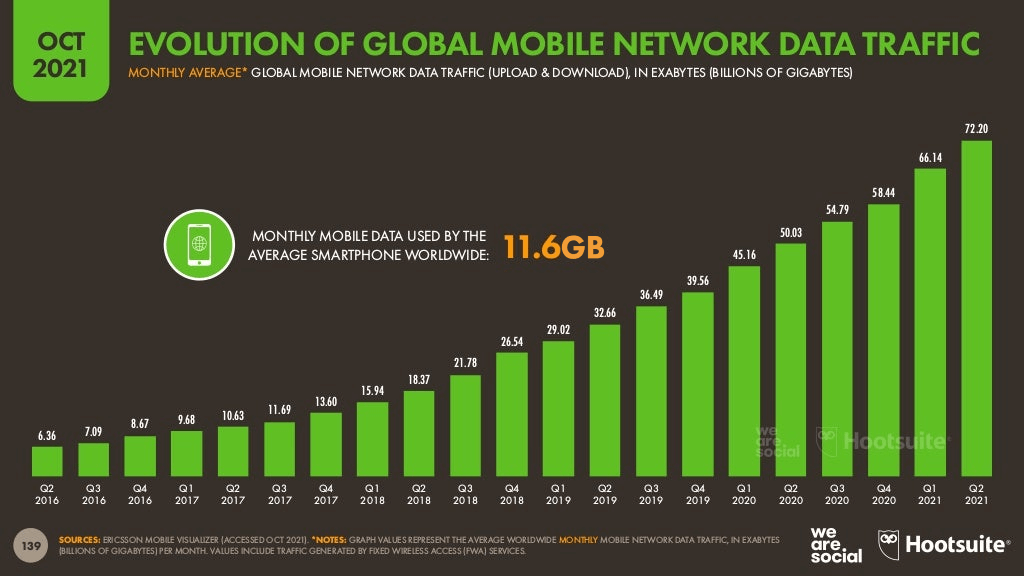
Mobile data consumption has risen 10-fold, from 6 exabytes (EB) to 39 EB (1 EB is 1000000000GB or 1.0E18 bytes or 1e+9 gigabytes) at the end of 2019, and it has doubled in 2 years, reaching 72.2 EB – which is a tremendous jump!
Total monthly global traffic consumption changes:
- In Q3-2016, the total monthly global data traffic was 7.09 EB.
- In Q3-2018, that number spiked beyond 20 EB – a more than 66% increase!
- In Q3-2019, it reached 36.5 EB – around a 55% increase over a year.
The monthly average mobile data consumption by a single user:
- The monthly mobile data consumed by the average smartphone user worldwide was 2.9GB in Q3-2017.
- By Q4-2019 that usage grew to 7.2GB – more than a + 148% spike!
- By Q4-2021 it reached 11.6GB – a 61% increase compared to the previous year.
When looking ahead to 2024 and beyond, Ericsson, one of the world’s leaders in providing Information and Communication Technology (ICT) to service providers, predicts a radical jump in the distribution of mobile data.
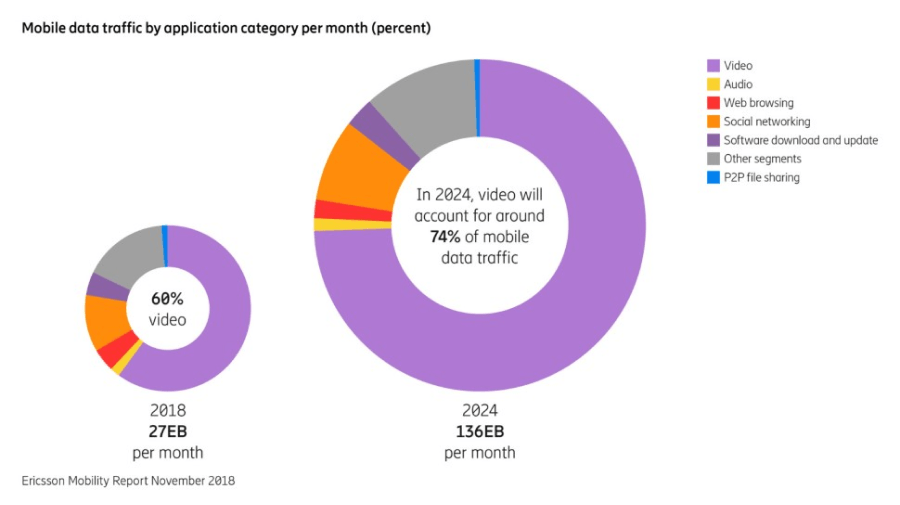
Image source Ericsson Mobility Report 2018
The company sees the introduction of 5G as being instrumental to how content will be generated and distributed over mobile devices. According to their data, there has been a quicker adoption of the 5G technology compared to when 4G technology was introduced.
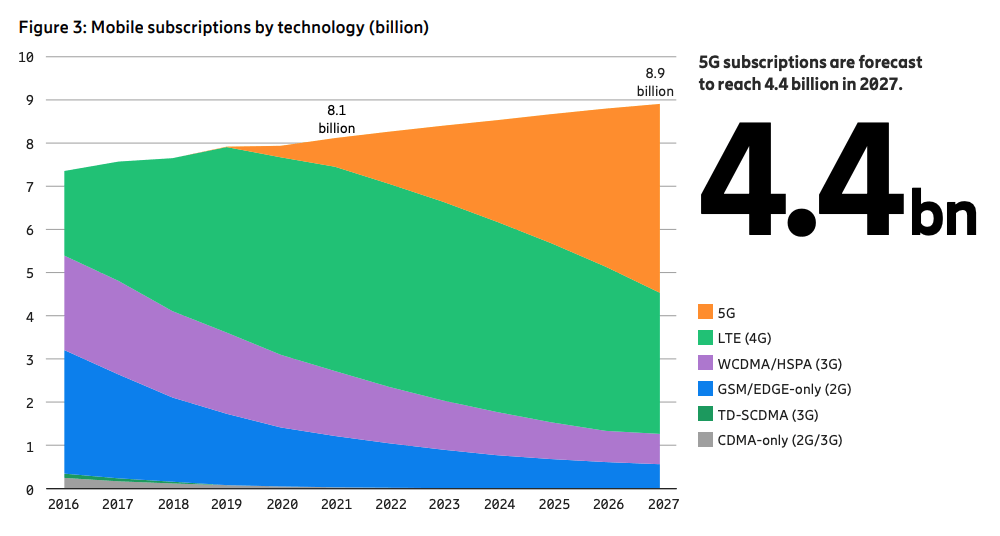
Image source Ericsson Mobility Report November 2021
With the growing popularity of eLearning and “learning on the go,” it’s only logical to assume that new learning platforms will tap into those evolving trends to also deliver newer learning experiences to platform users.
While learners did use LMS-based “cataloged learning” in previous years, they did so largely to comply with corporate or professional mandated training requirements, and not necessarily because these courses were supposed to help them. For their other “every day” learning experiences, they turned to the internet and watched videos and podcasts or consumed other content – primarily via mobile-enabled devices.
This surge in internet and mobile usage has not only delivered better learning experiences to learners but facilitated the emergence of new learning platforms – LXPs – that tap into those new learning experiences.
2. The growth of generated content
Digital content has seen tremendous growth in recent times. To get a sense of how much data is generated and consumed every minute, all we need to do is look at some of the stats compiled by cloud-based operating system provider Domo:
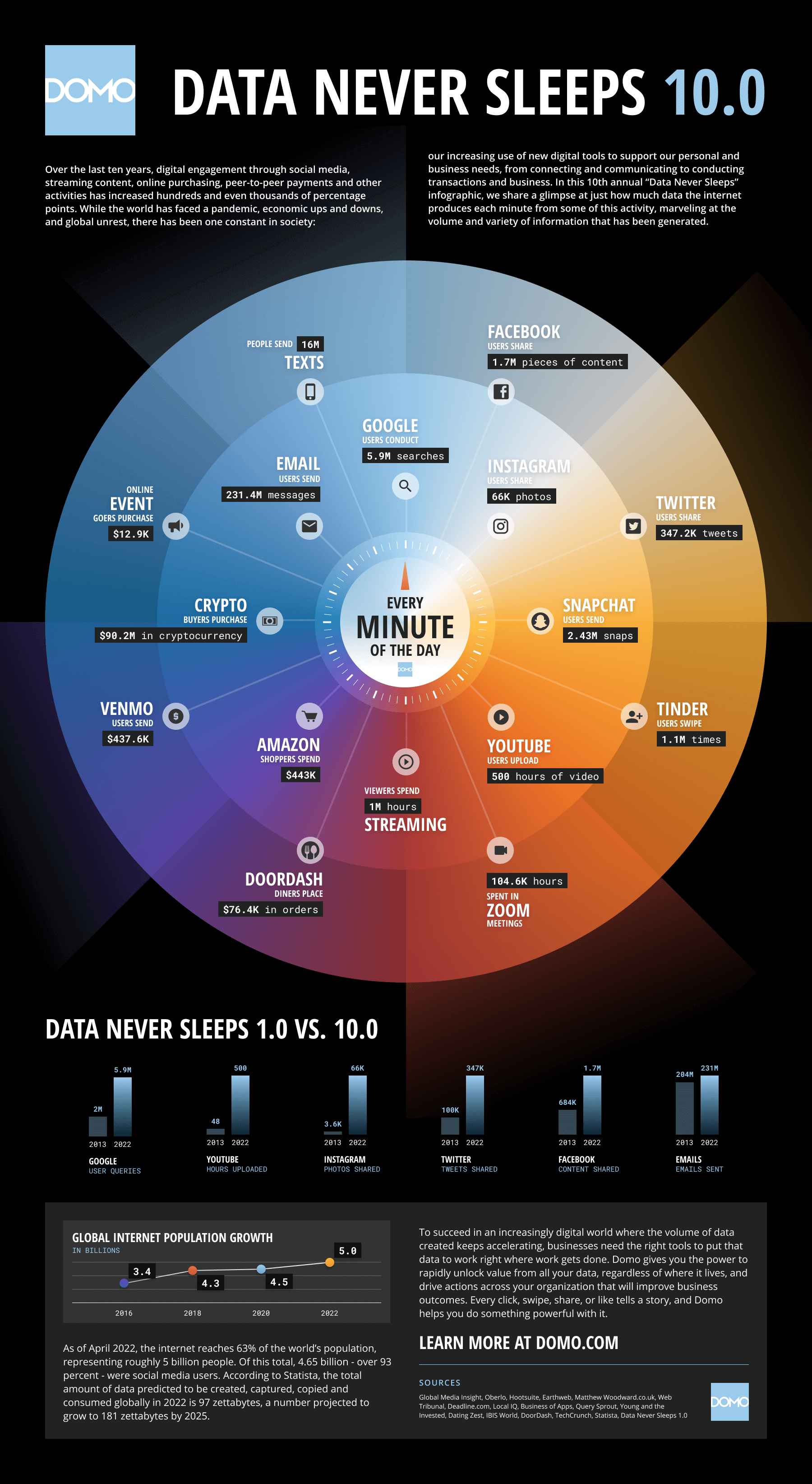
Image source Domo Data Never Sleeps 10.0 report
How much data is generated every minute?
- 16 m texts messages sent
- 5,9 m searches on Google
- 1.7 m Facebook content shared
- 231 m emails sent
- 104,600 hours spent in Zoom meetings
- 347,000 Tweets shared
- 500 hours of video uploads on YouTube
- 66,000 photos shared on Instagram
- and other types
Compare how big the leap of the generated data is for the past ten years.
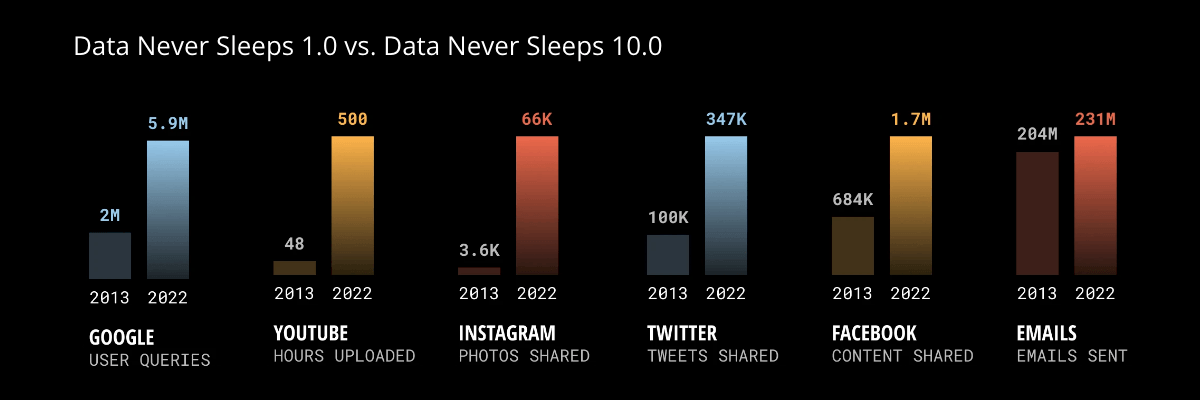
While the bulk of this content contributes to entertainment, eCommerce and personal communications, a significant chunk of it is also geared towards educational use. For instance, if you need to learn about something, all you need to do is “Google search” that topic for an appropriate “YouTube” video – and you’ll get the exact content you are searching for!
The internet, and by extension mobile devices, created a new learning model – one that transcended the boundaries of how people learned.
No longer was it essential to be tied to a desk – or a desktop! – or a physical location (classroom, conference room or learning center) for learning content to be consumed.
As a result of the many changes, data consumption via mobile devices curated personalized content, and through “smart” devices will be more valuable than content consumed via traditional methods.
The growth of social learning has also created multiple learning opportunities for people to share their knowledge and expertise. As they socialize on these platforms (Facebook, LinkedIn, YouTube, Instagram and many others), individuals and groups learn from each other through various types of social interactions – sharing content, exchanging mutually-liked links to external content.
LXP leverage similar approaches in corporate learning environments, and scale learning experience and opportunities with such user-generated content as found in social and community-based learning.

Is your company set for a digital learning solution?
You can quickly assess strengths, weaknesses, and areas for improvement with the template.
DOWNLOAD checklist3. Technological revolution
Traditional DXPs and conventional approaches to digital transformation largely embraced the digitization of existing content and processes. That typically meant converting what’s already there and giving users a new experience by wrapping the existing with new digital user interfaces. But new technologies, like Data Analytics, Artificial Intelligence (AI), Virtual Reality (VR) and Augmented Reality (AR), have changed all of that.
These new-era developments have drastically changed how content is produced – especially in a learning context. The availability of high-speed data transmission, higher-quality chips and processors, cloud computing services and mass storage solutions have opened new venues for content producers to channel their creativity. As a result, learning platforms too have embraced those opportunities to deliver newer experiences to their constituents.
But revolutions in technology have also meant that it’s now a lot easier to create content – usually of higher-quality than before. And because innovations in technology have made scaling content creation more practical, content is produced more cost-effectively (cheaper!) as a result.
4. Changes in content distribution
New ways of content distribution, such as subscription-based and Software-as-a-Service (SaaS) are also changing the content availability landscape.
Consumers are:
- Gravitating to paid subscription models for their content, like Netflix and Amazon Prime Video, Apple TV.
- Watching Video-on-Demand (VoD) content from their cable networks on their mobile devices
- Accessing free online entertainment and learning videos through YouTube
- Opting to download content from ecosystems like Apple’s iTunes or Amazon MP3
- Choosing to stream content from platforms like Spotify
- Turning to social entertainment portals like Facebook Games for online leisure content
- Using eBook publishers, like Independent Publishers Group (IPG) to get access to thousands of titles from their favorite authors
- Enjoying podcasts on various topics, either live, on-demand or downloaded, through podcast search engines like Listennotes
Even corporate users are voraciously contributing to data consumption using meeting and collaboration tools like Skype and GoToMeeting, and online graphics tools like Photoshop and Figma.
The gradual shift, from one-time pay to cloud-based subscription-based business has lead learning platforms to also offer Software-as-a-Service (SaaS) models to their clients. As such content becomes part of digital learning networks, they are integrated into commercial learning solutions and then become part of broader LXPs.
Looking back at all these developments, from how new data consumption platforms evolved, to the emergence of newer content development approaches and publishing channels, it’s easy to understand why LXPs naturally evolved as a result of DXPs.
And because education and learning is such a large component of the post-digitization era, it’s not hard to comprehend how digital platforms are now being used to harness learning. And while the two ways don’t have a one-to-one predecessor/successor relationship, the evolution of one (LXPs) can certainly be traced to developments in the other (DXPs).
Key features of Learning Experience Platforms
So, what should one expect to find in a typical LXP?
Well, one of the fundamental features of LXPs, that sets them apart from LMSs, is that they include sophisticated content discovery capabilities. Learners aren’t restricted by canned catalog content but can seek out interesting content for themselves, while also being guided towards relevant content by the platform.
Here are some other characteristics that set LXPs apart from LMS’s:
1. Extensive integration capabilities
Extensive integration capabilities that enable connection to a much-varied set of ecosystems through which learning can be furthered. For example, LXP-LRS integration can help deliver insightful information (trends and patterns) – through data analytics – that can aid in personalizing learning even further.
Integrating AI with LXPs can enhance learning experiences even further. Communication widgets and gadgets, like Learning Bots, can help customize unique learning paths for employees and serve as personalized learning assistants.
They remind learners about key learning milestones (courses due, upcoming assignment submission deadlines) and provide helpful revision and reinforcement tips. These tools also make training recommendations based on data analyzed from various sources, including corporate systems integrated with the platform.
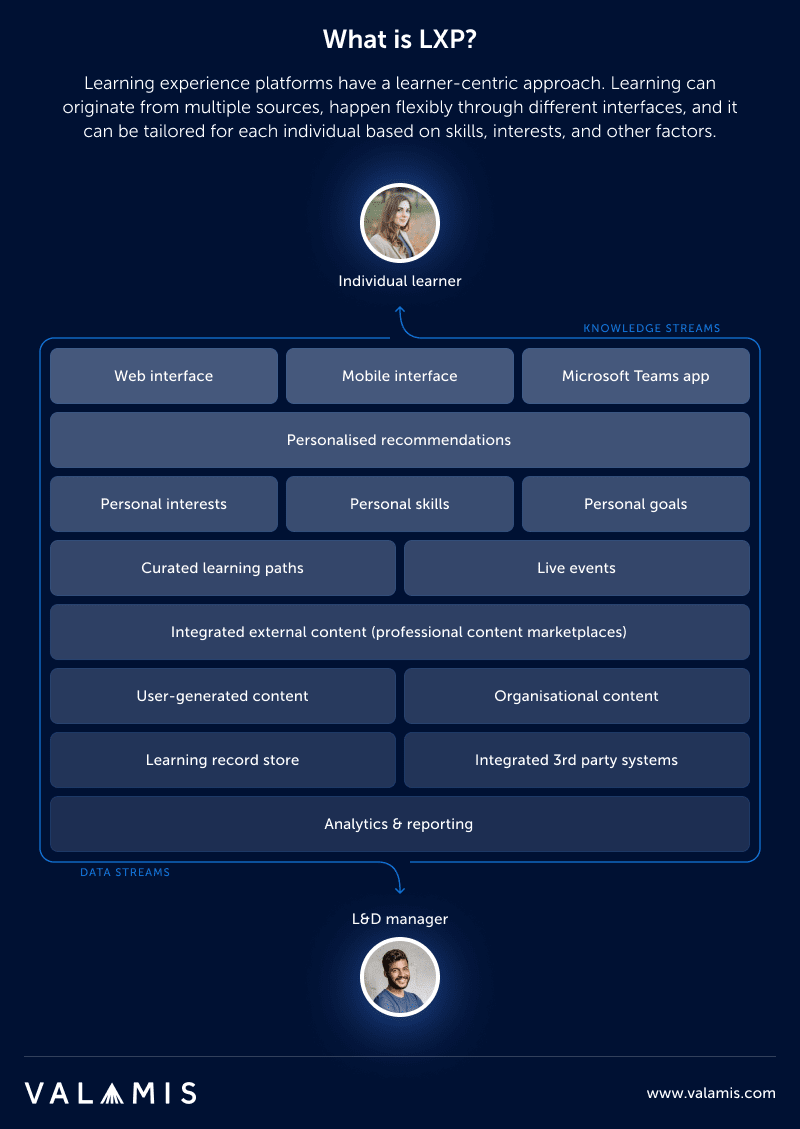
2. Rich learning experience through deeper personalization
The ability to provide a richer learning experience through deeper personalization and more wide-spread learning opportunities. By integrating with other platforms – Google Services, YouTube, Social Media, Communicational tools e.g. communication leader Slack – LXPs extend the learning experience beyond the corporate learning system.
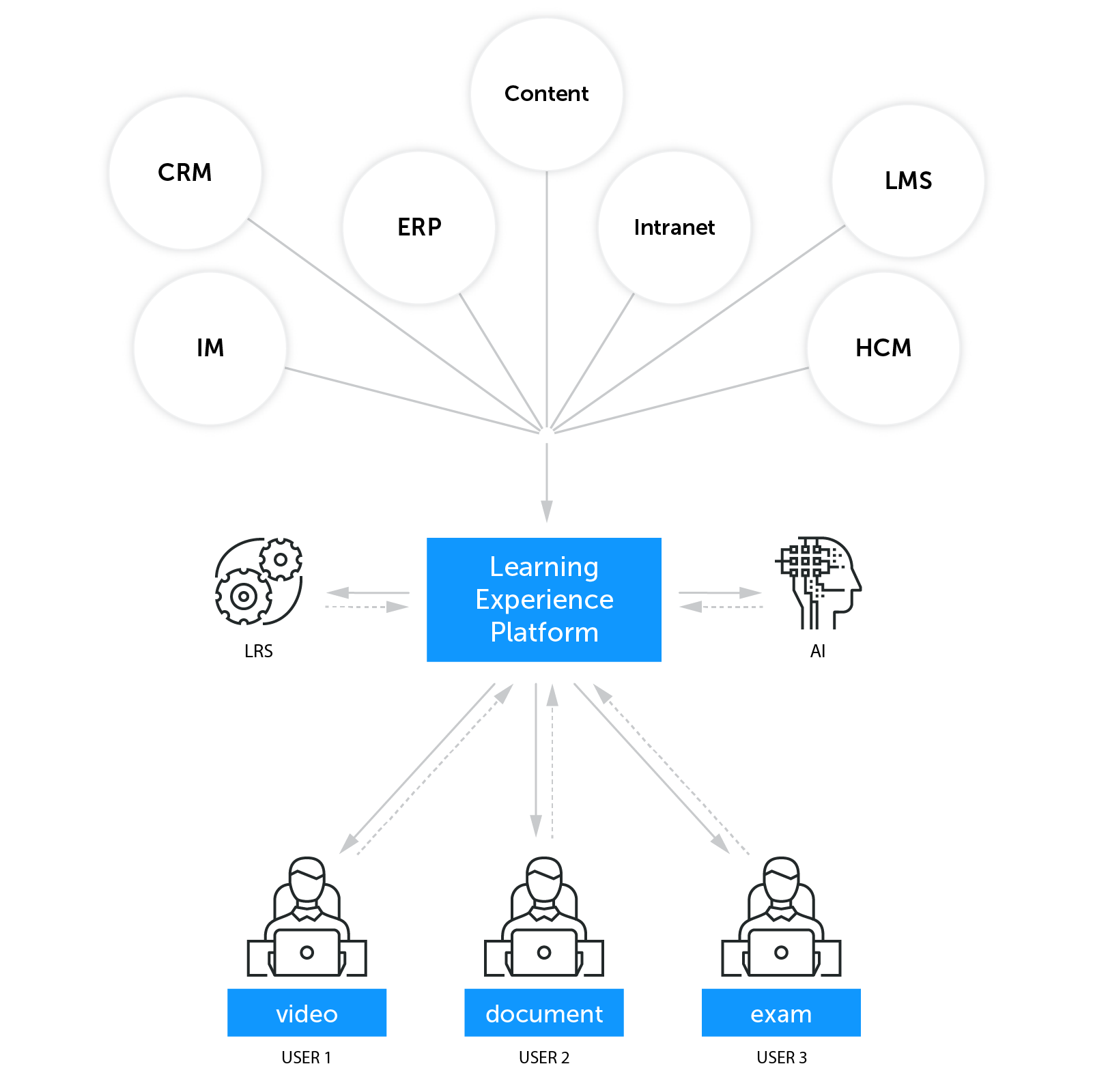
3. Supports various types of learning
Supports various types of learning, including problem-based learning, group-based learning, ILT, blended learning, through approaches such as Microlearning, Gamification and Adaptive Micro Learning.
4. Highly intuitive interfaces
They deliver content using highly intuitive interfaces, much like Netflix and Google do, based on past interactions and preferences. Through intelligent knowledge discovery (IKD), LXPs can provide highly adaptive, contextualized learning experiences based on the analysis of job performance, skills gaps and on-job competencies required.
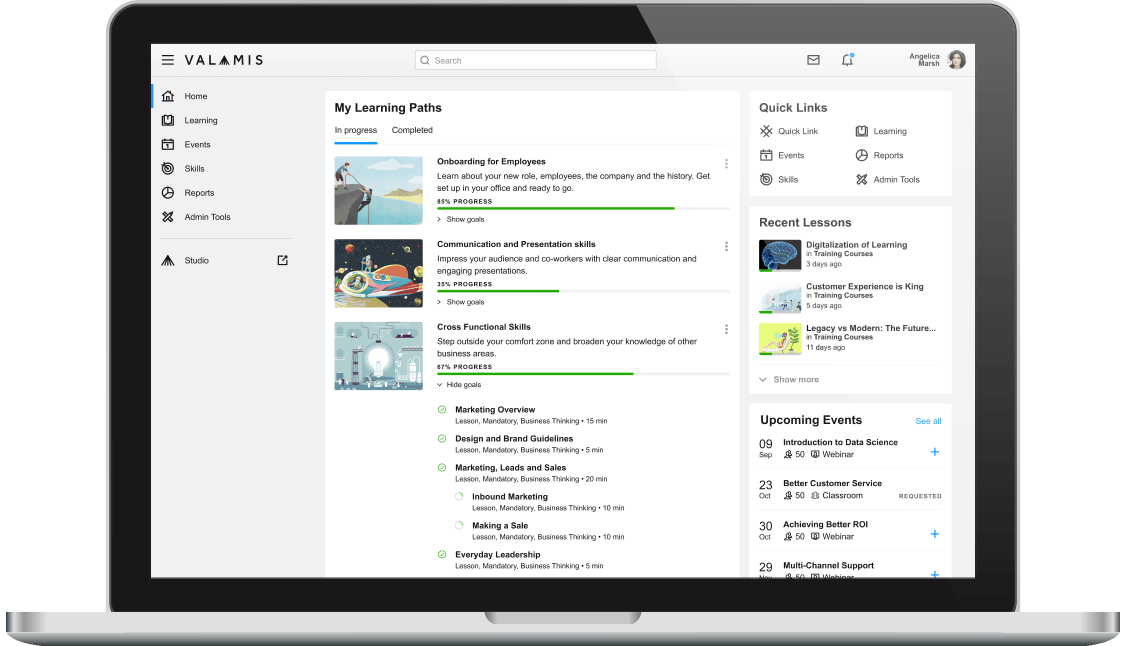
Overall, when compared to LMSs, training delivered through LXP’s tend to be more:
- responsive,
- individualized,
- contextual,
- ubiquitous in delivery.
As a result, LXPs deliver highly immersive learning experiences to users of the platform.
How do LXPs differ from LMSs?
We defined that, typically LMS is a standalone learning platform used in a company to monitor, track, report on and administer employees’ learning activities. They usually serve as digitized online course catalogs. Like a library, learners go to the LMS portal to search for and complete a course.
For more details take a look at our blog: LXP vs. LMS: Which Platform to Choose in 2024?.
Following video helps to crystallize the fundamental difference between traditional learning management systems and modern learning experience platforms.
Summary
In summary, LMS’s help companies organize and manage employee learning needs. They do this by making learning content available to users, and then track and manage the consumption of that content.
In contrast, LXP’s act as knowledge enablers that deliver a more personalized learning experience to platform users. While LMS’s help employees uncover relevant content in its repositories, LXP’s enable them to discover it even further afield and through a much broader variety of sources, resources and mediums. And when integrated with data analytics engines, LXPs can offer powerful insights into key metrics, including ROI, business outcomes and links between learning and on-job performance.
LXPs – Unlocking learner potential
Advances in technology helped all stakeholders in the learning industry to realize that there are better and more effective ways to help learners unlock their potential and achieve their learning objectives. Technologies such as Artificial Intelligence, Virtual Assistants, Machine Learning and, Natural Language Processing have enabled the building of learning platforms that deliver far more enhanced levels of learner experiences than the previous generation LMSs could.
LXP’s can facilitate continuous learning across the company. They allow employees (learners) the flexibility to personalize what they learn, how they learn and when/where they choose to learn. They can identify specific skill gaps by understanding roles, analyzing performance, assessing career paths and proposing either remedial or progression learning.
LXPs are ideal for continuous learning. They can help employees enhance their productivity by fostering peer-learning or by making recommendations for mentors or “buddies”. They can also tap into social learning to ensure learning continues even after work.
A few years ago, because of corporate LMS platform limitations, the ability to integrate and download already-created courses or even purchase a membership/access to courses wasn’t even an option. Today, LXPs enable you to easily go to Coursera or any other external course provider and find a course you are looking for. And because of their powerful cross-platform support, you can even start taking your course on PC and finish it on your smartphone.
In search of better opportunities, employees today feel the need to continually improve their knowledge and skills – and not just for “statutory compliance”. Modern content services got people used to the idea that they can easily locate personalized and relevant content “on demand” – free from the corporate LMS network. HR managers also realized the benefits of being able to integrate critical processes like onboarding, performance measurement and learning management for the growth and development of their employees.
It was this intense need for newer, better, faster, measurable and more personalized experiences that have made enterprise LXPs a necessity.

